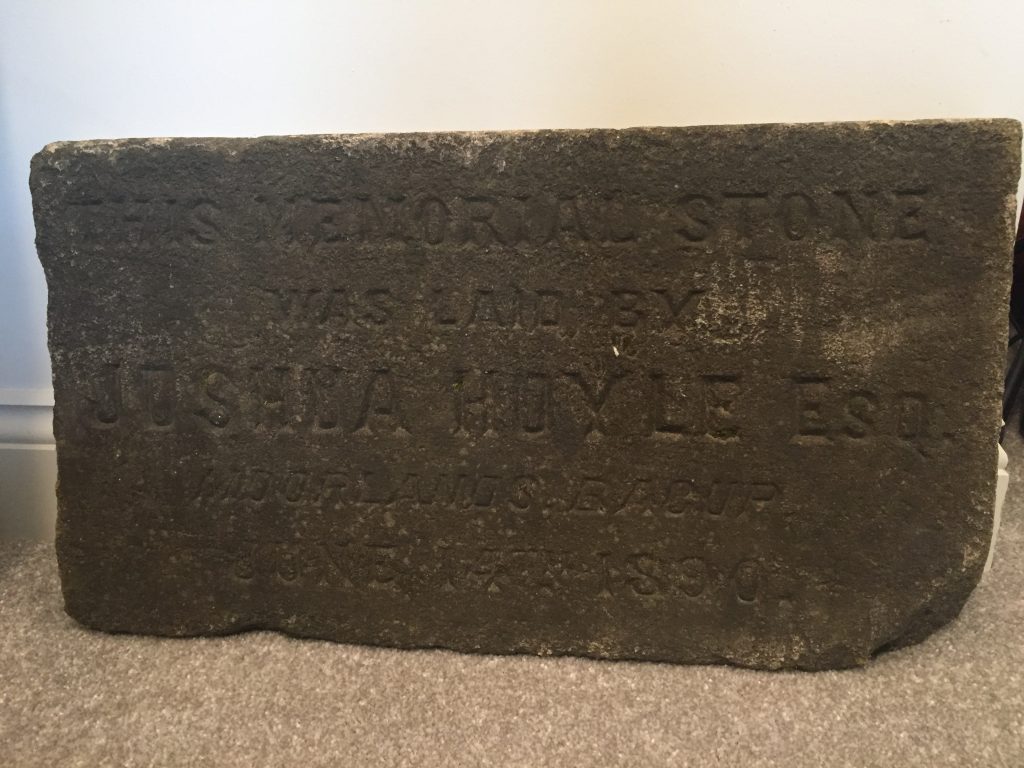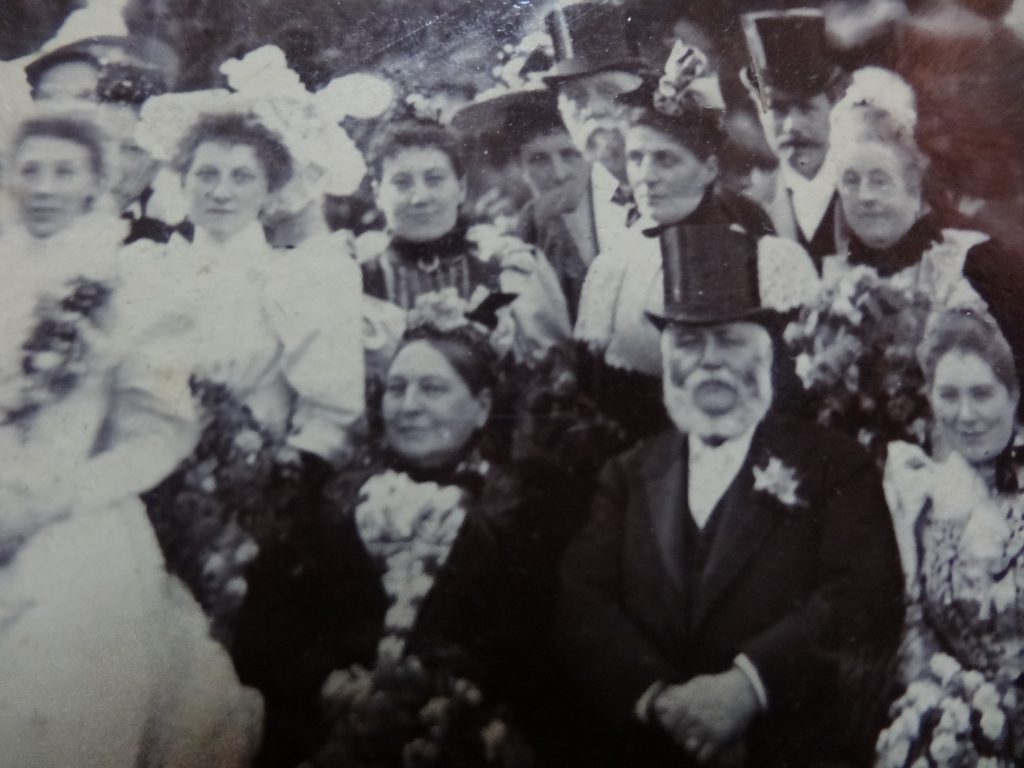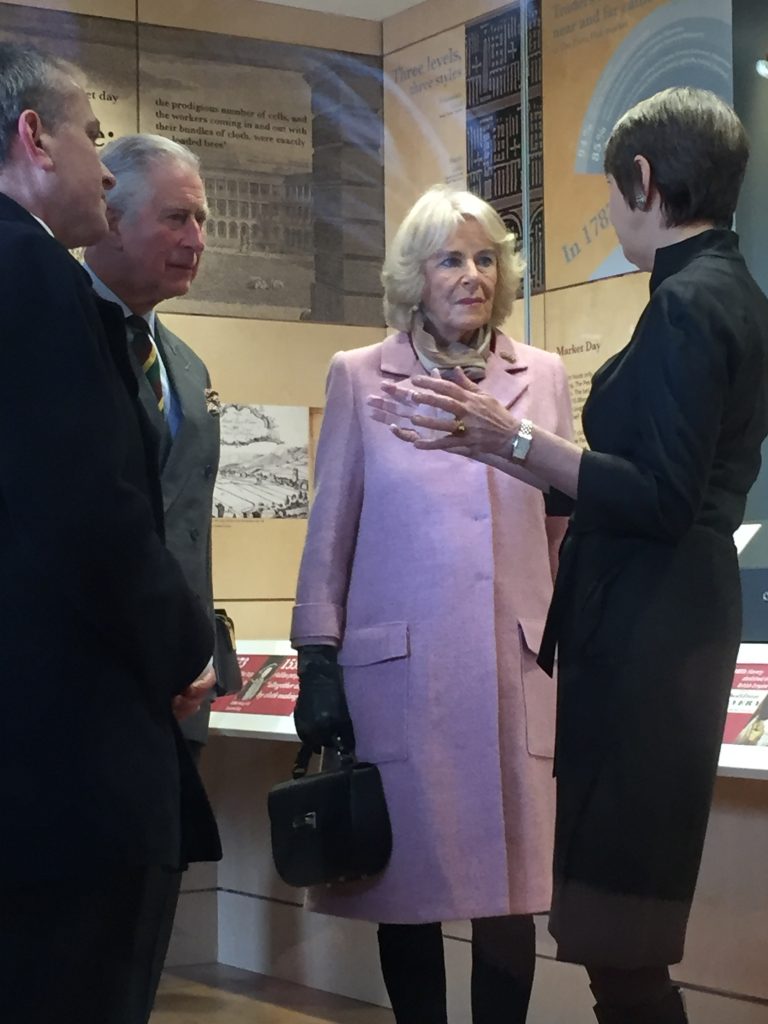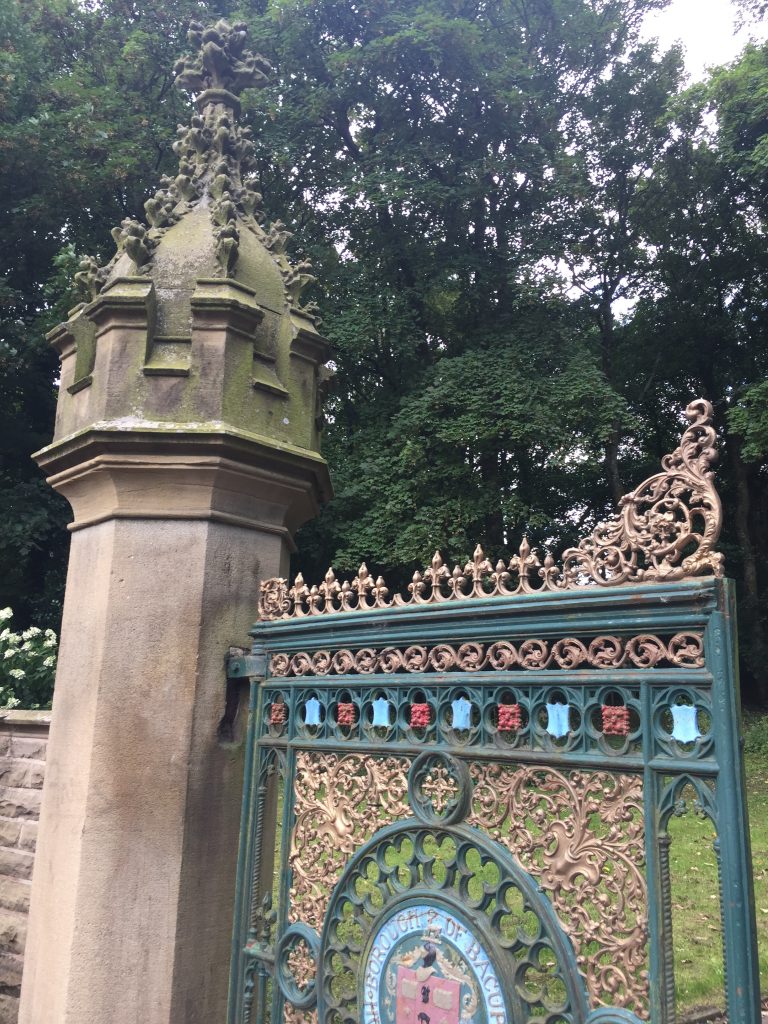Yesterday I received the delivery of a stone. It measures 14″ x 28″, is 2″ thick and weighs a ton. Well, maybe not quite a ton, but I certainly can’t move it, let alone pick it up, but the stone mason who delivered it managed to carry it up the stairs and plant it against the wall in my music room.

So, what’s the story? Well, it all began on rainy November day last year, November 2nd to be precise. I was out for a walk trying to pick a time between the showers, and find a path that wouldn’t be knee deep in mud, so I walked along the towpath and along Mayroyd road towards the railway station. On the approach to the bridge over the River Calder a pile of large blackened stones had been gathered supporting a big red sign- Road Closed: use Palace House Road.

Ah, I thought, there must be a safety issue preventing vehicles from using the bridge. But then I noticed that the top most stone had some writing carved into its upper surface: ‘This memorial stone was laid by Joshua Hoyle, Esq, Moorlands, Bacup, June 14th 1890.’ That’s interesting, I thought.

I have a Joshua Hoyle in my family tree, who also issued from Bacup, a small town in Rossendale, 10 miles from where I was standing in Hebden Bridge. I wonder if it could possibly be the same person. Close to the bridge is Whittaker’s stone mason’s workshop so I poked my head into the door and was soon chatting with Richard Whittaker. His father and grandfather had owned the business and he recalled that they worked on a demolition job in Bacup! but he had no idea how or when the stone had made its way from Bacup to Mayroyd Bridge but he told me that the stone could be cut down in size, made much thinner and he would even deliver it to my apartment. I told him that I’d have to do more ancestry research to see if this Joshua was ‘my’ Joshua. The upshot was its delivery yesterday, but the story even involved many many hours of research, and I felt as if I was getting more and more mired into the mud. The primary problem being that there were two Joshua Hoyles who lived almost next door to each other in Bacup and they were both owners of textile manufacturing companies! The story does have its own royal ending because there’s a connection with Camilla Parker-Bowles, yes – Mrs Prince Charles – who I saw at an event in the Piece Hall in Halifax in 2018.



As I set out to find my possible connection to Joshua Hoyle of Moorlands I was contacted by member of the Hoyle family through Ancestry.com. I asked if she knew anything about a Joshua Hoyle living at Moorlands. “Hello, regarding Moorlands, my Gt grandfather, Joshua Craven Hoyle sold the business in 1919 due to the damp weather in Lancs and he was recommended to move south. He moved to South Devon. On leaving he gave the house and gardens to the council. I guess it was them that decided that the house (a very unattractive monstrosity) was to be knocked down and the gardens made into the park.” She added “I happened to be in Bacup in the early 1980’s when they knocked down either India or Plantation mill and I picked up some bricks.” So she too, like me now, has a physical piece of the Hoyle’s empire.

So what was the Hoyle Empire? Joshua Hoyle and Sons was a firm of cotton spinners and manufacturers, originally founded by Joshua Hoyle in 1834 at Plantation Mill in Bacup. In 1854 his two youngest sons, Edward and Isaac, took over the family’s mills and its Manchester business respectively, Joshua dying in 1862. The company (motto: ‘no test like time’) gained a reputation for benevolent management and in 1873 its workers were given the opportunity to buy shares. In 1891 the firm had five mills operating 101,000 spindles and 3,000 looms. Brooksbottom Mill was then their principal production site with 61,560 spindles and 1,082 looms. In 1906 they moved the Manchester headquarters from Mosley Street to a new purpose-built steel-framed warehouse, National Heritage List for England (‘List’) entry 1271127.

‘My’ Joshua Hoyle was the son of Edward and Frances Craven – hence the Craven name. By the age of 24 he was living with his cousin, William Hoyle, 26 in Ramsbottom, a small town dear to my family’s heart, and they are listed in the 1891 as cotton manufacturers. 2 years later he married Mary Beatrice Law Schofield at the parish church in Rawtenstall and the new family lived at Oak House in Bacup. With the death of his father in 1897 it seems that Joshua and Mary moved into Moorlands, Edward’s home. Edward’s will shows that he left 147,000 pounds to family members including Joshua. That’s around 16 million pounds in today’s money.

Edward Hoyle 
Edward Hoyle (Joshua’s dad) 
Edward and Frances at Joshua’s wedding 
Wedding of Joshua and Mary Beatrice, 1893 
Joshua with his daughter and grand daughter
During the first world war Joshua saw service in Egypt (embarked as Lt Col 9/9/1914 with the East Lancs Regiment) From Joshua’s grand daughter I learned that “in 1919 Joshua, his wife Mary Beatrice and my grand mother, Frances, moved down to South Devon – to Gnaton Hall, a house I knew well. It was sold in 1978ish, and became to family home of one of Lord Roborough’s sons. His son married Camilla Parker-Bowles daughter. They now live there. I guess Camilla would visit.”

Hawthorn House Hawthorn House is situated on the road to Bacup across the road from what most people will know as E Sutton & Son’s Riverside works. The house was built by Edward’s father, Joshua – senior – between 1844-1849, (not to be confused with Joshua Hoyle of Olive House). If the walls could talk the house could tell the tale of the building and demolition of India Mill.

Joshua the son of Abraham and Sarah Hoyle was born in 1796. In 1834, he went into business with John Maden at Midge Hole, building Throstle Mill two years later. By 1841 Joshua had built Plantation Mill living across the road from the mill until the completion of Hawthorn House. Joshua and his wife Elizabeth had four sons, James, John, Isaac and Edward (Moorlands House) and one daughter Alice. Joshua died at the house in 1859: India Mill wasn’t built until three years after his death. Both Edward and Isaac took a keen interest in the welfare of their employees and by 1873 the workforce held one-fourth of the concern as partnership shares.

https://www.heritagegateway.org.uk/Gateway/Results_Single.aspx?uid=1585419&resourceID=19191
https://www.gracesguide.co.uk/Joshua_Hoyle_and_Sons.
The story of the Hoyle manufacturing empire is beyond the scope of this page in my blog. It’s a complex story and there is so much information that I find it overwhelming, but the Grace’s guide is a good place to start, with lots of posters advertising the business.
The former warehouse of Joshua Hoyle and Sons stood derelict for many years until it was converted and extended and opened as the Malmaison Hotel in 1998. [6]

What building the stone that started off my research was actually commemorating is probably lost in the mists of time. For my own connection with the Hoyles see a former page in my blog: http://blog.hmcreativelady.com/2021/03/31/my-new-connection-with-old-town/
Many thanks to Ann for sharing the family photos.
Update: August 21, 2022

At last the day arrived when I would visit the site of Moorlands and see if anything remained. It was mid afternoon when I took the bus to Todmorden and then the bus to Bacup. It had been raining until lunchtime and I’d given up my idea of hiking in the hills so, when the sun came out, I decided to visit Moorlands.

An impressive gate heralded the entrance of Stubbylee and Moorlands park on the outskirts of Bacup. The park was well signposted with maps showing children’s playgrounds, rose gardens, woodland, cafe, duck pond and there were lots of people enjoying the open space on this Saturday afternoon. I came to a large building housing council offices and a citizen’s advice centre but the building looked much more impressive than its current function.

A lady and grandchild were sitting on a bench enjoying the view of the duckpond and i asked her if she knew anything about the origins of the building. She didn’t but suggested I asked at the cafe. The cafe was just closing for the day but the staff referred me to several information boards on the side of the old aviary and there I found what I was looking for.

The entire park has extensive plans including some working involving Moorlands.

I went in search of the sunken garden which was close by the now demolished house and by following a few little paths through the woodland I came across piles of used stone, some carved into formal shapes, looking very much as if they were from some elegant building, perhaps even parts of fireplaces.
Then I found a large retaining wall barely visible in the undergrowth. Returning to the information boards, sure enough, the stones are on the site of the original moorland house, and, what’s more, there are plans to ‘clear away some vegetation and expose areas of wall from the original hall that stood here – The Moorlands.’ Also ‘interpretation relating to the house,’ and ‘opportunities for archaeological digs.’ Perhaps they would be interested in the stone in my music room!

In May 2023 I learned from someone who had read my blog about my connection with Moorlands that the lintels above the door frames and window frames on Moorlands Terrace had been made from the demolished hall.






10th May 2023 at 9:19 pm
Interesting article. Not sure if you know this but the houses which form Moorlands Terrace were built using the remains of Moorlands Hall. If you go on street view you can see that the stone lintels from the hall have been re-used over the doors and windows on the terrace of houses.
1st November 2023 at 1:10 pm
Id like to correct the information regarding the handover of Moorlands Hall.
Moorlands Hall was handed over to Bacup Corporation well before Joshua moved away. On the 30th of April 1912, following a family meeting, one of the trustees of Edward Hoyle, namely his son Joshua Craven Hoyle wrote to the Bacup Town Council offering to give the Moorlands Estate to the Council. The Bacup Natural History Society archives contain the full Bacup Borough Minutes for the handover of the house. The area of rubble in your photos is actually what was the tennis courts and croquet lawn of the house and the remains of the home farm.